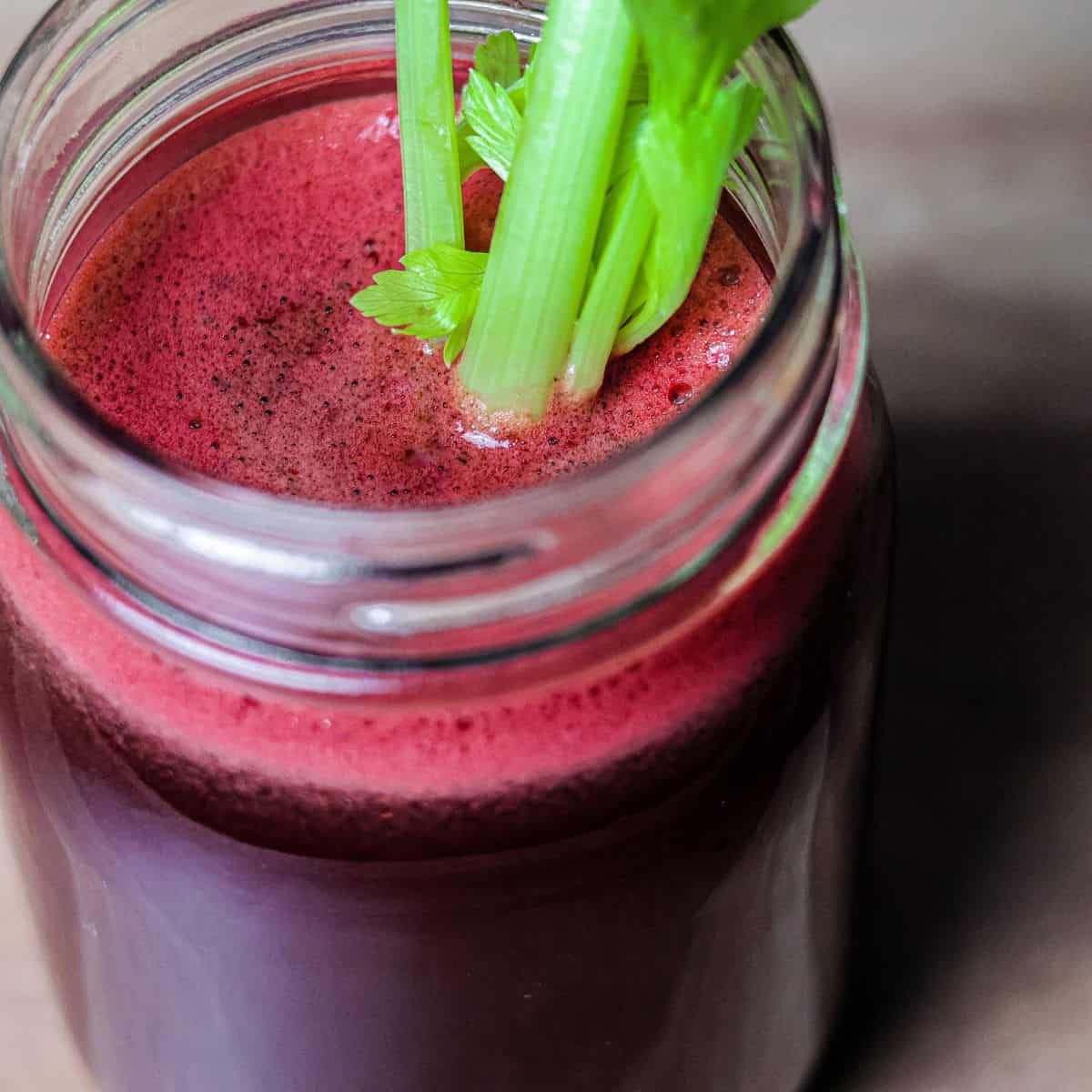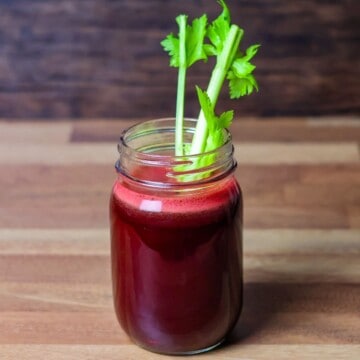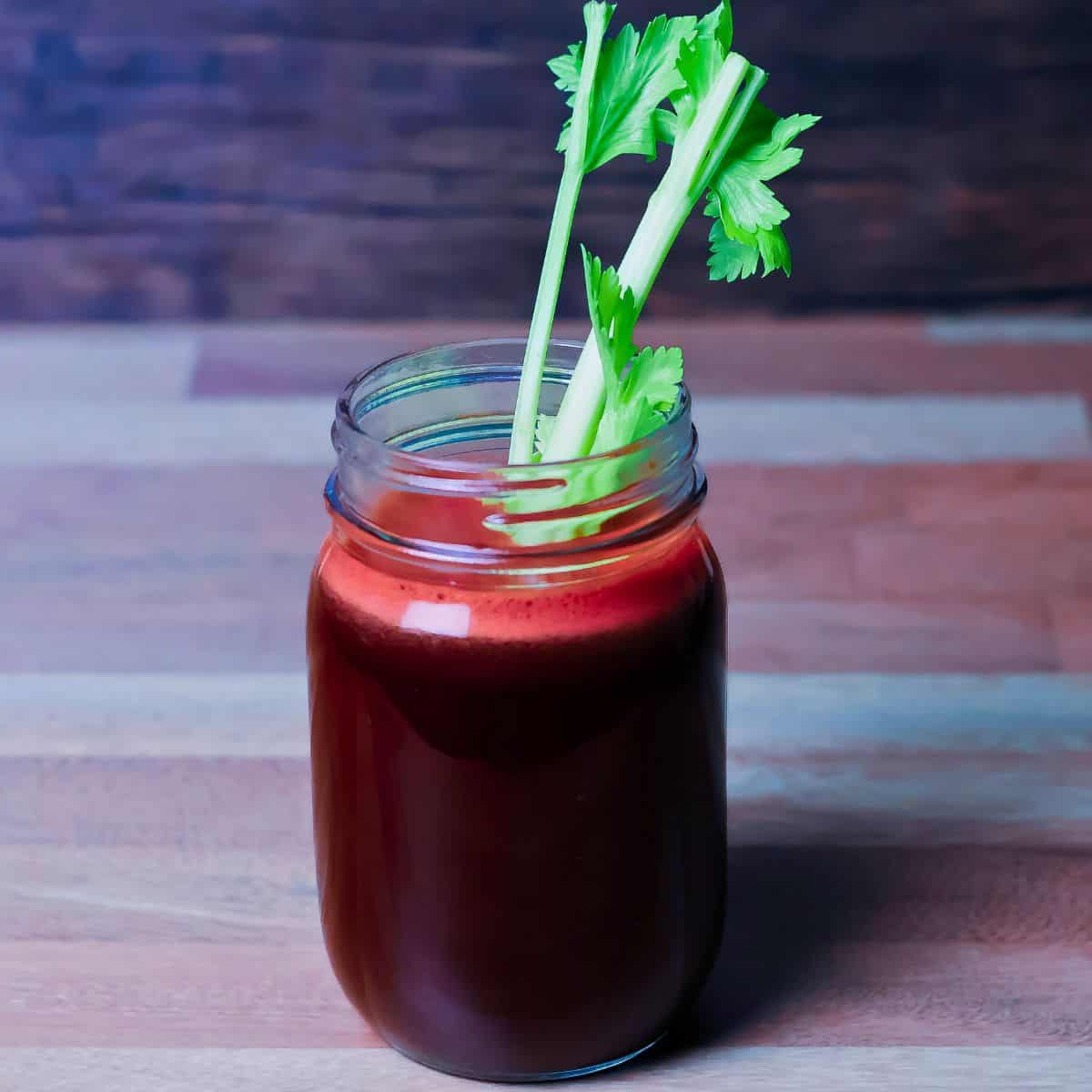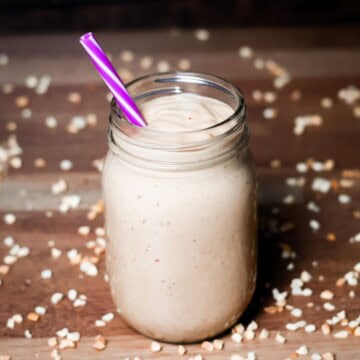Get ready for a refreshing experience with our colon cleanse juice recipe. It's a tasty elixir of green apples, ginger, lemon, and beet juice, designed to support your digestive system and encourage a healthy bowel movement.
I've spent years blending and juicing superfoods, and the benefits are clear in each vibrant glass. Take our turmeric lemon juice, homemade kale tonic, inspired by the beloved First Watch version, our sweet potato weight loss juice recipe, or our zesty anti-inflammatory shot—each recipe is a step towards better health.
This delicious colon cleansing juice recipe is a harmonious mix of sweet, tangy, and warm spice of ginger—so good, my kids ask for it repeatedly!
This particular beet recipe is a winner, but it's wise to enjoy it gently, as it's highly effective at activating the digestive tract.
Beet juice is a powerhouse, known for its energy-boosting properties, detox quality, and its rich array of phytonutrients that promote overall health. Plus, it offers a quick delivery of essential nutrients straight to your body's cells.
It's important to balance out juice with fiber-rich foods to feed gut flora and may also aid chronic constipation. Our mucoid plaque cleanse recipe, with its natural dietary fiber, is also worth exploring.
For a deeper understanding of the core benefits of a juice detox, from aiding irritable bowel syndrome to contributing to weight loss, check out our article on the benefits of cold-pressed juice. Our red or green juice is an ideal start to your day, especially on an empty stomach, to maximize the intake of extra nutrients. The best part? It complements a well-balanced diet, ensuring your gut health is well cared for. Join us in sipping towards a healthier you!
Before beginning, I'd like to invite you to take a deep breath and set healthy intentions for your juice. It can be as simple as you like. For more insights, our guide to setting intentions is ready to help enrich your wellness routine.
Jump to:
Ingredients for Colon Cleanse Juice

Understanding the source of your produce is crucial when creating a juice meant for cleansing and health; organic options ensure you're sipping on the benefits, not the pesticides.
Green Apples: Rich in vitamin C, apple juice is a staple in colon cleansing recipes. It provides ample nutrients and may help to reduce mucus buildup.
Lemon: Bursting with vitamin C, lemon juice adds a tangy freshness and can help to brighten your immune system. It's a key player in the best colon health routines.
Ginger: Known for its ability to soothe digestive discomfort, ginger juice is a boon for those with leaky gut issues. It also contains gingerol, which may help to lower high blood pressure.
Cucumber: With its high water content, cucumber adds hydration to vegetable juices, while delivering vitamin K for blood clotting and heart health.
Celery Stalks: These are more than just a crunchy snack—celery provides a source of vitamin E, antioxidants, and amino acids, making a positive impact on overall health.
Beetroot: Beet juice is a powerhouse of nutrients, including vitamin B and nitrates that are beneficial for blood flow and can lower blood pressure.
Spinach: This leafy green is a nutrient-dense ingredient in any juice, offering iron, calcium, and a boost to the immune system.
Instructions
Before you start washing your produce, give it a thorough spray with a 1:1 ratio mixture of warm water and white vinegar. This simple yet effective solution helps to kill bacteria on the surface of your fruits and vegetables. Allow it to sit for at least one minute before rinsing it off and scrubbing. This extra step ensures your produce is not only clean but also safe for juicing, enhancing the overall quality and health benefits of your juice.

Prepare Your Ingredients: Start by giving all your ingredients a good wash. Cleanliness is key to a healthy juice. Peel the lemon and ginger to avoid any bitter taste. Then, chop the beet, apples, cucumber, and celery into manageable pieces that will easily go through your juicer.

Juicing Process: Dive into the juicing by starting with the softer items, like spinach and green apples. Their moisture content is ideal for getting the juicing process going smoothly. Next, introduce the ginger, beet, cucumber, and celery. This order helps in maximizing the juice yield from each ingredient.

Finish with Lemon: Cap off your juicing with the lemon. Its citrusy zing not only enhances the flavor but also ensures any leftover bits from the previous ingredients are flushed through, maximizing your juice output.

Stir and Enjoy: Once the juicing is complete, give your concoction a thorough stir to blend all the flavors. Serving the juice immediately after preparation ensures you're getting the peak nutritional benefits.

Hint: To get the most out of your juicing experience, alternate between softer and more fibrous produce. Always end with a juicy fruit like lemon. This technique ensures a smoother juicing process and a deliciously balanced flavor profile.

Variations and Substitutions
In the realm of juicing for colon health, flexibility is key. Here are some versatile options to tailor your juice to your taste and health needs:
Fruits and Veggies Swap: Feel free to experiment with different fruits and vegetables. Carrots add sweetness plus a boost of vitamin A, while kale introduces calcium and vitamins K, C, and A, fortifying your juice with extra nutrients.
Aloe Vera Juice: Integrating aloe vera juice into your blend or consuming it separately is fantastic for digestive health. It's known for its natural laxative properties and gut-healing benefits.
Apple Cider Vinegar: A splash of apple cider vinegar can elevate your juice, offering probiotics for gut health and aiding in natural detoxification.
Blending for Fiber: For those who prefer not to miss out on fiber, consider blending your ingredients into a smoothie. This keeps the fiber intact, offering a different approach to support the digestive tract.
Using a Blender: No juicer? No problem. Use a blender for your fruits and vegetables and then strain the mixture through a fine mesh strainer or nut milk bag to achieve a smooth juice consistency.
By exploring these variations and substitutions, you can keep your colon cleanse routine fresh, effective, and aligned with your dietary preferences and needs.
Storage
To preserve the freshness and nutritional value of your colon cleanse juice, proper storage is key. Freshly made juice is best enjoyed immediately after juicing, but if you need to store it, here are a few tips:
- Refrigeration: Store your juice in a tight-sealed glass container to maintain its quality. It's ideal to consume it within 24 hours, but it can last up to 48 hours if necessary.
- Avoid Plastic: Plastic containers can leach chemicals into your juice and may not keep it as fresh as glass can.
- Fill to the Top: To minimize oxidation, fill your storage container to the brim to reduce the amount of air in contact with the juice.
- Keep It Cold: Always keep the juice cold to slow down the degradation of nutrients and flavors.
Top tip: Chew Your Juice
It might sound unusual at first, but "chewing" your juice can significantly enhance its health benefits. When you go through the motions of chewing, even without solid food, your salivary glands are activated. This is more than just a quirk of digestion; it's a crucial step in the digestive process.
The saliva produced during chewing is rich in digestive enzymes, such as amylase, which starts the breakdown of carbohydrates right in your mouth. By "chewing" your juice, you're essentially pre-digesting it, allowing these enzymes to start their work early. This can lead to improved absorption of nutrients and a smoother digestive process overall.
So next time you enjoy a glass of juice, take a moment to swish it around in your mouth, mimicking the chewing motion. This simple action primes your digestive system, making it ready to efficiently handle the influx of nutrients from your freshly pressed juice. Not only does it maximize the nutritional benefit, but it also encourages mindful eating practices, enhancing your overall juicing experience.
FAQ
Juices that are particularly good for colon cleansing include those high in antioxidants, and vitamins. Some of the best options are:
Green Juice: Made with leafy greens like spinach or kale, cucumber, and celery, offering chlorophyll to support detoxification.
Beet Juice: Contains betalains, which have detoxifying properties and support liver health.
Apple Juice: Contains Malic Acid, which can help improve digestion.
Lemon Ginger Juice: Lemon aids in detoxification and ginger stimulates digestion, both supporting colon health.
To empty your bowels completely and quickly, a combination of dietary, positional, and lifestyle changes can be effective:
Increase Fiber Intake: Eat more fruits, vegetables, and whole grains to stimulate bowel movements.
Stay Hydrated: Drink plenty of water throughout the day to help soften stool and promote movement.
Exercise Regularly: Physical activity encourages bowel movements by reducing the time food stays in the large intestine.
Use a Squatty Potty: Elevating your feet while on the toilet can put your body in a more natural squatting position, which may help to facilitate a more complete and easier bowel movement.
You can tell your colon is empty when you experience certain signs during or after a bowel cleanse, such as:
Decreased Bowel Movement Frequency: After clearing out, you might notice a temporary reduction in the need to go.
Feeling Lighter and Less Bloated: Many people report feeling physically lighter and less bloated once their colon is fully emptied.
Ease of Bowel Movements: When your colon is empty, passing stools becomes more effortless.
More Juice and Smoothies
Looking for other recipes like this? Try these:
Recipe

Delicious Homemade Colon Cleanse Juice Recipe
Equipment
- cutting board
Ingredients
- 2 green apples cored and sliced
- 1 large beet peeled and quartered
- 1 inch ginger peeled
- 1 lemon peeled
- 1 large cucumber sliced
- 4 celery stalks
- 1 cup spinach leaves
Instructions
- Prepare Your Ingredients: Wash all ingredients thoroughly. Peel the lemon and ginger. Chop the beet, apples, cucumber, and celery into sizes suitable for your juicer.
- Juicing Process: Start with the softer ingredients (spinach and apples) before moving on to the ginger, beet, cucumber, and celery. This order helps to maximize juice yield.
- Finish with Lemon: Juice the lemon last to ensure any remaining bits from other ingredients are pushed through, adding a fresh kick to the juice.
- Stir and Enjoy: Combine the juice well before serving. For the best nutrient intake, consume immediately or follow storage advice if needed.
Notes
This colon cleanse juice recipe is a wonderful way to start your day or as a midday boost, offering a delicious path to improved gut health and vitality.
Nutrition
Final Thoughts
Did you try this yummy drink? Please share your experience in the comments below. We love hearing from you!
Don’t forget to subscribe for more healthful drink recipes and tag us on social media with your beautiful juice creations. Your journey enriches our community.
When it comes to juicing, the debate between centrifugal juicers and masticating juicers is worth mentioning.
We lean towards the slow juicer (masticating) for its gentle extraction method, which helps preserve the juice taste and nutrients.
However, centrifugal juicers are also a viable option, especially for their speed and convenience. Both types will work wonderfully for your homemade juicing needs.
Remember, each glass of juice is a great way to nourish your body and support your wellness goals. Whether you’re new to juicing or a seasoned enthusiast, exploring different drink recipes can be a delightful and healthful adventure.
Be well,
Natalie











Comments
No Comments